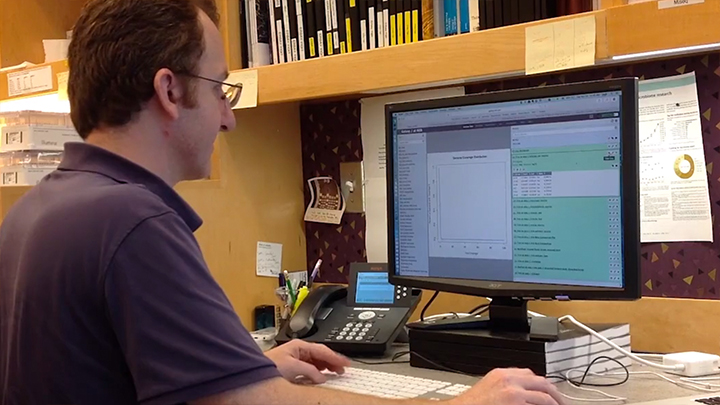Behind the paper: Comprehensive Profiling of GSL Glycans Using a Broad Specificity Endoglycoceramidase in a High-Throughput Workflow
Script
My name is Christopher Taron. I’m the Scientific Director of Protein Expression and Modification research at New England Biolabs.
In this study, we sought to create a comprehensive workflow for the characterization of glycosphingolipid glycan headgroups. This research was a collaboration between my lab here at NEB and lab of Pauline Rudd at the National Institutes of Bioprocessing Research and Training in Dublin, Ireland.
Over the past 10 years, the field of glycomics has been steadily growing. This has largely been due to increases in analytical sensitivity and the availability of better reagents to permit comprehensive structural profiling of glycans from complex mixtures.
The goal of the paper was to create a workflow that permitted structural characterization of glycosphingolipid glycan headgroups. This was important because the field needs to start to explore glycans that are circulating in the mammalian bloodstream outside of N-linkedglycans. So, glycosphingolipids are complex lipids that are found to populate the surface of mammalian cells and are also sometimes found in the bloodstream. There's literally hundreds of different structural variants of glycosphingolipids, otherwise known as geocells. Therefore they're an interesting reservoir of structural complexity of glycans in the mammalian glycome.
Over the past decade, there have been numerous studies that have been implicating the structure of circulating glycans – often N-linked glycans – on glycoproteins…and changes in that glycome in response to different diseases. The field has mostly settled in on studying N-linked glycans…that's largely because N-linked glycans can be released from proteins very easily with the enzyme PNGase F. After that, they can be chromatographically profiled.
The problem with glycosphingolipids, is there hasn't been an enzyme that permits a wide variety of glycosphingolipids to ultimately be released from the lipid and structurally profiled. A key element of the study that we conducted in this report involved the identification of a novel and endoglycoceramidases that could release a greater number of glycosphingolipid head groups than known endoglycoceramidases.
The difficulty with the analysis of O-linked glycans and glycosphingolipids, is that there's no analogous broad-specificity enzyme that will released these carbohydrates intact. So, in this study, we sought to try to identify a broader-specificity endoglycoceramidase, and develop a workflow that would permit the high-throughput characterization of liberated GSL headgroups.
In this study, Dr. Saulius Vainauskas, from my laboratory, biochemically characterized numerous different endoglycoceramidases for their ability to hydrolyze a wide variety of GSL structures. We selected an enzyme from Rhodococcus triatomae that had an ability to hydrolyze gangliosides, cerebrosides, and globosides – a specificity that's much wider than previously reported endoglycoceramidases. In addition, previous enzymes from Rhodococcus had to be produced in Rhodococcal expression systems. Yet, for the Rhodococcus triatomae enzyme, we were able to solve protein expression in E. coli.
Armed with this enzyme, Dr. Simone Albrecht, at NIBRT, was able to establish a high-throughput semi-automated, robotic workflow for the characterization of the GSL headgroups, which included chromatographic profiling using UPLC/HILIC with fluorescence detection. Simone went on to use this workflow to demonstrate analysis of GSLs that were liberated from membranes, isolated from various mammalian cells, and also to provide the first chromatographic characterization of GSL headgroups circulating in the human bloodstream.
Now that we have a workflow for structural profiling of GSLs that are circulating in the bloodstream or in cellular membranes, the field can use this workflow to go and start to better understand the variety of GSLs that are present on the surface of cells, or in the human bloodstream – and how they potentially change in response to normal physiological changes in the human body, or in response to the disease state.
So, one of the applications of this method, going forward, will be to look at biomarker discovery – for example with N linked glycans. The field has been able to match changes in N-linked glycan structure with the onset of certain different certain diseases, certain cancers, schizophrenia, rheumatoid arthritis, for example. Analogous studies will now be permitted using a different type of carbohydrate – glycosphingolipid headgroups.
And so, it's our anticipation that we’ll be able to find interesting new correlations between disease and circulating GSL structure using this methodology. We have made the paper open-access. We have a narrated slide deck available on the ACS website, and the paper is also available on Research Gate.
Related Videos
-

Behind the Paper: Using the Human Methyl-Binding Domain to Partition Genomic DNA Derived from Plant Tissues -

Behind the Paper: An engineered Fbs1 carbohydrate binding protein for selective capture of N-glycans and N-glycopeptides -

Behind the paper: High-temperature single-molecule kinetic analysis of thermophilic archaeal MCM helicases

